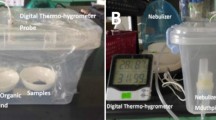Abstract
The effect of moisture on the adsorption of ammonia was systematically studied using different surface materials and humidity levels. The experimental water amount fractions varied between 6 and 18,000 µmol mol−1, and the ammonia amount fraction was 400 nmol mol−1. The investigated materials included plain 316L stainless steel and stainless steel cured with Dursan, SilcoNert 2000 and halocarbon wax coatings. Furthermore, Teflon (PTFE) and polyvinylidene difluoride (PVDF) polymer surfaces were studied. Dynamically diluted ammonia, test tubes prepared with the investigated materials, a commercial ammonia analyzer based on cavity ring-down spectroscopy, and a commercial dew-point transmitter were employed. The adsorption was assessed quantitatively using continuous flow conditions and real-time monitoring of the adsorption process. The ammonia adsorption was found to increase substantially in dry conditions for all the studied materials except PVDF. The increase was largest for plain stainless steel which was the most adsorbing material. The coatings applied on stainless steel decreased the adsorption significantly in dry conditions. Polymers PVDF and PTFE were the least-adsorbing materials. In water amount fractions between 1000 and 10,000 µmol mol−1, the ammonia adsorption was at its lowest. The adsorption increased again above 1% humidity levels.





Similar content being viewed by others
References
M.A. Sutton, J.W. Erisman, F. Dentener, D. Möller, Environ. Pollut. 156, 583 (2008)
B. Timmer, W. Olthuis, A. van den Berg, Sens. Actuators B 107, 666 (2005)
K. von Bobrutzki, C.F. Braban, D. Famulari, D.S.K. Jones, T. Blackall, T.E.L. Smith, M. Blom, H. Coe, M. Callagher, M. Ghalaieny, M.R. McGillen, C.J. Percival, J.D. Whitehead, R. Ellis, J. Murphy, A. Mohacsi, A. Pogány, H. Junninen, S. Rantanen, M.A. Sutton, E. Nemitz: Atmos. Meas. Tech. 3, 91 (2010)
A. Pogány, D. Balslev-Harder, C.F. Braban, N. Cassidy, V. Ebert, V. Ferracci, T. Hieta, D. Leuenberger, N. Lűttschwager, N. Martin, C. Pascale, C. Tiebe, M.M. Twigg, O. Vaittinen, J. van Wijk, K. Wirtz, B. Niederhauser: Meas. Sci. Technol. 27, 115012 (2016)
Handbook of Stainless Steel (Outokumpu Oyj, Sandvikens Tryckeri AB, 2013)
S. Tardio, M.-L. Abel, R.H. Carr, J.E. Castle, J.F. Watts, J. Vac. Sci. Technol. A 33, 05E122 (2015)
S. Yamamoto, T. Kendelewicz, J.T. Newberg, G. Ketteler, D.E. Starr, E.R. Mysak, K.J. Andersson, H. Ogasawara, H. Bluhm, M. Salmeron, G.E. Brown, A. Jr, Nilsson, J. Phys. Chem. C 114, 2256 (2010)
M.H.M. Ahmed, X. Torrelles, J.P.W. Treacy, H. Hussain, C. Nicklin, P.L. Wincott, D.J. Vaughan, G. Thornton, R. Lindsay, J. Phys. Chem. C 119, 21426 (2015)
C. Leygraf, in Corrosion Mechanisms in Theory and Practice, 3rd edn., ed. by P. Marcus (CRC Press, Boca Raton, 2012), p. 675
C.L. Wang, B. Zhou, P. **u, H.P. Fang, J. Phys. Chem. C 115, 3018 (2011)
O. Vaittinen, M. Metsälä, S. Persijn, M. Vainio, L. Halonen, Appl. Phys. B 115, 185 (2014)
A. Schmohl, A. Miklos, P. Hess, Appl. Opt. 40, 2571 (2001)
R.A. Ellis, J.G. Murphy, E. Pattey, R. von Haarlem, J.M. O’Brien, S.C. Herndon, Atmos. Meas. Tech. 3, 397 (2010)
J.D. Whitehead, M. Twigg, D. Famulari, E. Nemitz, M.A. Sutton, M.W. Gallagher, D. Fowler, Environ. Sci. Technol. 42, 2041 (2008)
G. Picarro, Analyzer for NH3, User’s Guide (Picarro Inc., Sunnyvale, 2010)
R.J. Yokelson, T.J. Christian, I.T. Bertschi, W.M. Hao, J. Geophys. Res. 108, 4649 (2003)
Halocarbon Products Corporation. http://www.halocarbon.com, Accessed 21 April 2018
C.W. Kammeyer, D.R. Whitman, J. Chem. Phys. 56, 4419 (1972)
Acknowledgements
This work is part of European Metrology Research Programme (EMRP) Joint Research Project (JRP) “Metrology for Ammonia in Ambient Air”—MetNH3 (http://www.metnh3.eu). O. V. was employed as a Research Excellency Grant (REG) beneficiary in the Project. The research was carried out with funding by EURAMET and the European Union. The EMRP is jointly funded by the EMRP participating countries within EURAMET and the European Union. SilcoTek Corporation is thanked for supplying the SilcoNert 2000 and Dursan-coated stainless steel test tubes and for providing an additional information about the coatings. Dr. Hannu Sairanen from VTT MIKES Metrology is acknowledged for verifying the appropriate operation of the Vaisala dew-point transmitter. Dr Raimo Timonen is thanked for providing a prepared halocarbon wax solution. Funding was provided by European Association of National Metrology Institutes.
Author information
Authors and Affiliations
Corresponding author
Rights and permissions
About this article
Cite this article
Vaittinen, O., Metsälä, M., Halonen, L. et al. Effect of moisture on the adsorption of ammonia. Appl. Phys. B 124, 189 (2018). https://doi.org/10.1007/s00340-018-7054-2
Received:
Accepted:
Published:
DOI: https://doi.org/10.1007/s00340-018-7054-2




